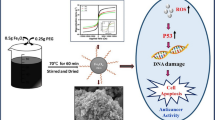Abstract
Unique nanosized designed ceramic powders, Fe-doped hardystonite (Fe-HT) with the chemical composition of Ca1.85Fe0.15ZnSi2O7 (0.15Fe-HT) and Ca1.75Fe0.25ZnSi2O7 (0.25Fe-HT), were synthesized by the sol–gel method in order to develop a multifunctional bioactive powder for hyperthermic and tissue engineering applications. Characterization techniques such as X-ray diffraction analysis, transmission electron microscopy, Fourier transform infrared spectroscopy and energy-dispersive X-ray spectroscopy were used to investigate the structural characterization of the obtained powders. The results showed that nanocrystalline single-phase Fe-HT powders were successfully synthesized by sol–gel method. The prepared nanopowders had structural properties such as crystallite size (~53 nm), crystallinity degree (~55 %) and lattice strain (~0.355 %) for 0.15Fe-HT and crystallite size (~40 nm), crystallinity degree (~41 %) and lattice strain (~0.401 %) for 0.25Fe-HT. The obtained Fe-HT nanopowders are expected to be a suitable candidate for tissue engineering and also hyperthermia-based cancer therapy.
Graphical Abstract







Similar content being viewed by others
References
Seiler JG, Johnson J (2000) lliac crest autogenous bone grafting: donor site complications. J South Orthop Assoc 9:91–97
Greenwald AS, Boden SD, Goldberg VM, Khan Y, Laurencin CT, Rosier RN (2001) Bonegraft substitutes: facts, fictions, and applications. J Bone Joint Surg Am 83:98–103
Nayab SN, Jones FH, Olsen I (2005) Effects of calcium ion implantation on human bone cell interaction with titanium. Biomaterials 26:4717–4727
Carlisle EM (1986) Silicon as an essential trace element in animal nutrition. Ciba Found Symp 121:123–139
Yamaguchi M, Oishi H, Suketa Y (1987) Stimulatory effect of zinc on bone formation in tissue culture. Biochem Pharmacol 36:4007–4012
Zreiqat H, Ramaswamy Y, Wu C, Paschalidis A, Lu Z, James B, Birke O, McDonald M, Little D, Dunstan CR (2010) The incorporation of strontium and zinc into a calcium–silicon ceramic for bone tissue engineering. Biomaterials 31:3175–3184
Corchero JL, Villaverde A (2009) Biomedical applications of distally controlled magnetic nanoparticles. Trends Biotechnol 27:468–476
Echeverria C, Soares P, Robalo A, Pereira L, Novo CMM, Ferreira I, Borges JP (2015) Mater Des 5:745–751
Gudovan D, Balaure PC, Mihăiescu DE, Fudulu A, Purcăreanu B, Radu M (2015) Curr Pharm Des 21:6038–6054
Long NV, Yang Y, Teranishi T, Thi CM, Cao Y, Nogami M (2015) J Nanosci Nanotechnol 15:10091–10107
Maver U, Bele M, Makovec D, Campelj S, Jamnik J, Gaberscek M (2009) J Magn Magn Mater 321:3187–3192
Ito A, Kobayashi T (2008) Intracellular hyperthermia using magnetic nanoparticles: a novel method for hyperthermia cancer. Jpn Soc Therm Med 24:113–129
Kalambur VS, Han B, Hammer BE, Shield TW, Bischof JC (2005) In vitro characterization of movement, heating and visualization of magnetic nanoparticles for biomedical applications. Nanotechnology 16:1221–1233
Mornet S, Vasseur S, Grasset F, Duguet E (2005) Magnetic nanoparticle design for medical diagnosis and therapy. J Biosci Bioeng 100:1–11
Lewinski N, Colvin V, Drezek R (2008) Cytotoxicity of nanoparticles. Small 4:26–49
Wu H, Wang T, Bohn M, Lin F, Spector M (2010) Novel magnetic hydroxyapatite nanoparticles as non-viral vectors for the glial cell line-derived neurotrophic factor gene. Adv Funct Mater 20:67–77
Li G, Zhou D, Lin Y, Pan T, Chen G, Yin Q (2010) Synthesis and characterization of magnetic bioactive glass–ceramics containing Mg ferrite for hyperthermia. Mater Sci Eng, C 30:148–153
Le Renard PE, Jordan O, Faes A, Petri-Fink A, Hofmann H, Rufenacht D (2010) The in vivo performance of magnetic particle-loaded injectable, in situ gelling, carriers for the delivery of local hyperthermia. Biomaterials 31:691–705
Aminian A, Solati-Hashjin M, Samadikuchaksaraei A, Bakhshi F, Gorjipour F, Farzadi A, Moztarzadeh F, Schmücker M (2011) Synthesisof silicon-substituted hydroxyapatite by a hydrothermal method with two different phosphorous sources. Ceram Int 37:1219–1229
Ahmadi T, Monshi A, Mortazavi V, Fathi MH, Sharifi S, HashemiBeni B, MoghareAbed A, Kheradmandfard M, Sharifnabi A (2014) Synthesis and dissolution behavior of nanosized silicon and magnesium co-doped fluorapatite obtained by high energy ballmilling. Ceram Int 40:8341–8349
Roohani-Esfahani SI, Chen Y, Shi J, Zreiqat H (2013) Fabrication and characterization of a new, strong and bioactive ceramic scaffold for bone regeneration. Mater Lett 107:378–381
Singh N, Jenking GJ, Asadi R, Doak SH (2010) Nano Rev 1:53–58
Cullity BD (1978) Elements of X-ray diffraction, 2nd edn. Addison-Wesley, San Diego, p 284
Landi E, Tampieri A, Celotti G, Sprio S (2000) Densification behavior and mechanisms of synthetic hydroxyapatites. J Eur Ceram Soc 20:2377–2387
Laugier J, Bochu B (2009) CELREF V3, Laboratoire des Matériaux et du Génie Physique Ecole Nationale Supérieure de Physique de Grenoble (INPG) Domaine Univer- sitaire BP 46, 38402 Saint Martin d’Hères, Cell parameters refinement program from powder diffraction diagram
Sreekanth RP, Chakradhar BM, Nagabhushana GT, Chandrappa KP, Ramesh JL (2004) Rao, solution combustion derived nanocrystalline Zn2SiO4: Mn phosphors: a spectroscopic view. J Chem Phys 121:10250–10259
Agathopoulos S, Tulyaganova DU, Venturaa JMG, Kannana S, Sarantic A, Karakassidesc MA (2006) Structural analysis and devitrification of glasses based on the CaO–MgO–SiO2 system with B2O3, Na2O, CaF2 and P2O5 additives. J Non-Cryst Solids 352:322–328
Nakamoto K (2009) Infrared and Raman spectra of inorganic and coordination compounds part A: theory and applications in inorganic chemistry, 6th edn. Wiley, Hoboken, p 156
Fernandez-Jimenez A, Palomo A (2005) Mid-infrared spectroscopic studies of alkali activated fly ash structure. Microporous Mesoporous Mater 86:207–214
Ma JG, Liu YC, Xu CS, Liu YX, Shao CL, Xu HY, Zhang JY, Lu YM, Shen DZ, Fan XW (2005) Preparation and characterization of ZnO particles embedded in SiO2 matrix by reactive magnetron sputtering. J Appl Phys 97:6
Aminian A, Solati-hashjin M, Samadikuchaksaraei A, Bakhshi F (2011) Synthesis of silicon-substituted hydroxyapatite by a hydrothermal method with two different phosphorous sources. Ceram Int 37:1219–1229
Wu C, Fan W, Zhu Y, Gelinsky M, Chang J, Cuniberti G, Albrecht V, Friis T, Xiao Y (2011) Multifunctional magnetic mesoporous bioactive glass scaffolds with a hierarchical pore structure. Acta Biomater 7:3563–3572
Acknowledgments
The authors are grateful for the support to this research by the Isfahan University of Technology.
Author information
Authors and Affiliations
Corresponding author
Rights and permissions
About this article
Cite this article
Farzin, A., Emadi, R. & Fathi, M. Novel sol–gel-derived hardystonite-based biomagnetic nanoparticles for hyperthermia applications. J Sol-Gel Sci Technol 80, 402–410 (2016). https://doi.org/10.1007/s10971-016-4100-6
Received:
Accepted:
Published:
Issue Date:
DOI: https://doi.org/10.1007/s10971-016-4100-6




